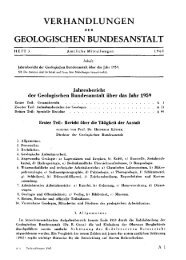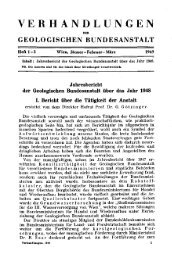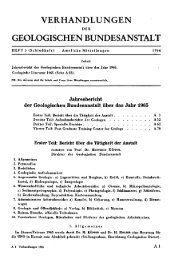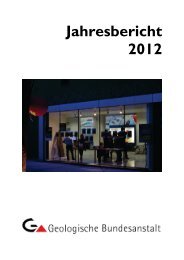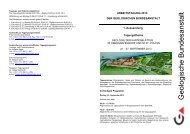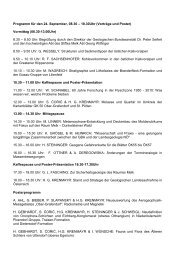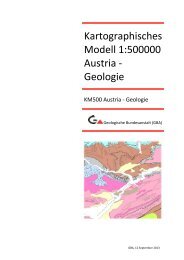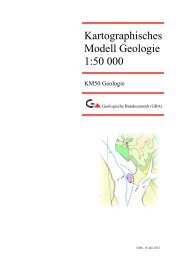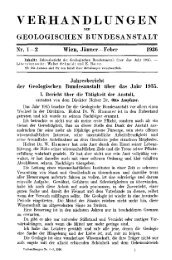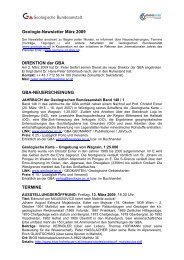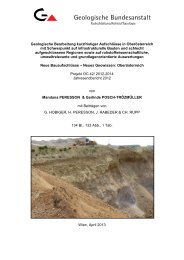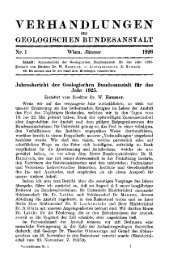Field Trip B TRIASSIC CONODONT LOCALITIES OF THE ...
Field Trip B TRIASSIC CONODONT LOCALITIES OF THE ...
Field Trip B TRIASSIC CONODONT LOCALITIES OF THE ...
Create successful ePaper yourself
Turn your PDF publications into a flip-book with our unique Google optimized e-Paper software.
duced and therefore are supposed to represent no suitable lithologies for detailed zonations. It is hoped<br />
that further study in areas with any thicker successions (Himalayas, western North America) will<br />
contribute to the new concept, confirm it or even refint the present state. The general zonal scheme<br />
presented here tollows wholly TOZER's work but uses pre-existing Tethyan indices.<br />
In a series of papers KOZUR 1972, 1973, 1974 a, b, 1975 contributed to the Upper Triassic ammonoid<br />
time scale. However, most of the proposed modifications are either based on hypothetical considerations<br />
or are subject of unsatisfying changes in the content of the historical stages and substages.<br />
KOZUR's contradicting opinions have been treated elsewhere (TOZER 1974, KRYSTYN 1974 b, 1978,<br />
TATZREITER 1978).<br />
Lower Karnian (= Julian)<br />
The Lower Karnian has been subdivided by KRYSTYN 1978 into two zones (Aonoides and Austriacum<br />
Zone) each of it including twosubzones (Aon and Aonoides Subzone, Austriacum and „Sirenites"<br />
Subzone respectively i The same sequence has newly been recognized in the Nepalese Himalayas (KRY<br />
STYN in press) and thus suggests an adequate standard for expressing worldwide correlations within<br />
this interval of time (KRYSTYN 1978, p. 53).<br />
Upper Karnian (= Tuvalian)<br />
TOZER 1967 and SILBERLING & TOZER 1968 distinguish three Upper Karnian zones, i. e., the<br />
Dilleri, Welleri. and Macrolobatus Zones. According to KRYSTYN 1973 the Welleri Zone is a junior<br />
synonym of the Tethyan Subbullatus Zone.<br />
The Dilleri Zone is one of the most poorly represented zones in the Tethyan Upper Triassic. Within<br />
the Salzkammergut it has been found only in quarry F 5 at Feuerkogel together with a distinct aramonoid<br />
fauna which is well comparable to that of the Californian type locality. The faunas of the two<br />
beds at Fauerkogel are identical, thus at the moment a subdivision of this zone is not possible.<br />
The middle Tuvalian Subbullatus Zone is subdivided mainly on the base of the later appearance of<br />
Tropites subbullatus (HAUER) together with a large and distinct tropitid fauna. The lower subzone is<br />
characterized by Projuvavites crasseplicatus (MOJS.), its first appearance marks the base of the zone.<br />
This subzone also represents the typical level with Discotropites sandlingensis (HAUER). Concerning<br />
the results mentioned above contrary to the opinion of KOZUR 1973 a Dilleri portion within the Subbullatus<br />
faunas of the Raschberg and Millibrunnkogel must be surely excluded. Despite of the tropitids<br />
clear correlation of Subbullatus and Welleri Zones is indicated by the presence of Projuvavites species<br />
(P. brockensisj which are closely related to Projuvavites crasseplicatus in the stratotype of the Welleri<br />
Zone.<br />
At present faunas of the Upper Tuvalian . Anatropites-Bereich" axe by far the best known. The<br />
division into two subzones has been proposed by KRYSTYN as early as 1974 a and has been confirmed<br />
in all sequences studied from Europe (Alps, Sicily) to the Far East (Himalayas, Timor). The lower subzone<br />
is characterized at its base by the appearance of Discotropites plinii (MOJSISOVICS) but the main<br />
feature of this subzone is the abundance of Jovites and Hoplotropites. The upper subzone apparently<br />
corresponds to the main layer of Anatropites, though the genus extends as far as the base of the zone.<br />
Other genera characterizing the upper subzone are Microtropites, Euisculites and Thisbites, the latter<br />
ranging to the lowermost Norian. Gonionotites cf. italicus GEMMELLARO has been designated as index<br />
because it is fairly abundant and yet the only species which spans the whole subzone.<br />
By comparison with the North American Macrolobatus Zone some problems arise. At its type-locality<br />
the lower Macrolobatus Zone is represented by a rich Tropites fauna (SILBERLING 1959). In the<br />
Tethys realm, however, Tropites s. str. ends at the upper boundary of the Subbullatus Zone. Hence,<br />
we assume that the lower part of the Macrolobatus Zone is coeval with the upper part of the Subbullatus<br />
or Welleri Zone, respectively. Good correlation exists between the Anatropites level of the upper<br />
Macrolobatus Zone described at its type-locality and faunas of the upper subzone of the Anatropites-<br />
Bereich elsewhere. Discotropites plinii and G. cf. italicus are both found in Canada (Mc LEARN 1960,<br />
TOZER pers. comm.)<br />
Lower Norian (= Lacian)<br />
The name of the lowermost Lacian zone has been changed by KRYSTYN (in press) to Guembelites<br />
jandianus Zone. The advantage of this species is its worldwide distribution and its well known stratigraphic<br />
range The zone is divided into two subzones based on a phyletic line between Dimorphites n. sp. 1<br />
and Dimorphites delectus MOJSISOVICS; both species have been known from Feuerkogel.<br />
The characteristic ammonoid faunas of the subzones have been stressed by KRYSTYN 1974 a. The-<br />
73



